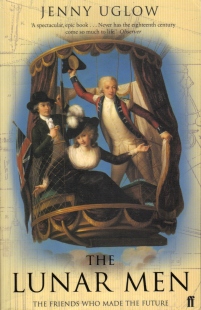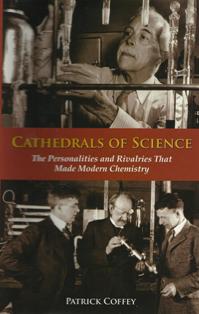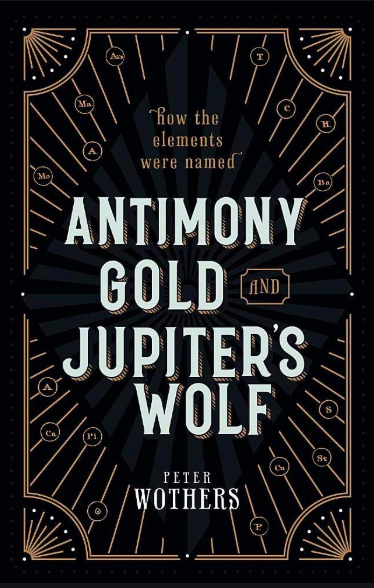Books for enjoyment
 A personal selection of books with links to Chemistry
A personal selection of books with links to Chemistry
All of the following are books with some links to chemistry that I have enjoyed reading. They can all be bought through reputable booksellers.
Book list
 Mysteries of the Quantum Universe, T. Damour & M. Burniat, 2020, Penguin, UK. ISBN 0 00 716376 2
Mysteries of the Quantum Universe, T. Damour & M. Burniat, 2020, Penguin, UK. ISBN 0 00 716376 2
This is actually a comic book and fans of Tintin will especially enjoy it as it covers the travels of Bob and his dog Rick as they meet various well-known contributors to the development of quantum mechanics. It is good for chemists at IB level as it explains clearly much of what is covered in the syllabus about quantum theory without the mathematics.
 Faraday – the life, J.Hamilton, 2003, Harper Collins, London. ISBN 0 00 716376 2
Faraday – the life, J.Hamilton, 2003, Harper Collins, London. ISBN 0 00 716376 2
Faraday was the assistant to Humphrey Davy who treated him more like a servant than a colleague. Nevertheless he went on to be one of the greatest scientists of the nineteenth century and perhaps the greatest ever experimental scientist. His notebooks are exemplary and he did much to inspire others and increase public understanding of science through his famous lectures.
 Uncle Tungsten, O.Sachs, 2001, Vintage Books, 0-375-40448-1
Uncle Tungsten, O.Sachs, 2001, Vintage Books, 0-375-40448-1
Memories of a chemical boyhood. A great book by Oliver Sachs who recounts his childhood days growing up with a fascination for chemistry. His experiments would probably all be banned now under Health and Safety regulations but his passion and wonder for chemistry is extremely infectious.
 What’s cooking in Chemistry?, H.P.Bell, T. Feuerstein, C.E. Günter, S. Hölsken and J.K. Lohmann, 2003, WILEY-VCH, Weinheim. ISBN 3-527-30723-0
What’s cooking in Chemistry?, H.P.Bell, T. Feuerstein, C.E. Günter, S. Hölsken and J.K. Lohmann, 2003, WILEY-VCH, Weinheim. ISBN 3-527-30723-0
This book combines organic chemistry with cooking. Over fifty leading organic chemists provide their own favourite recipe together with a biography and a resumé of their current research. Ideal for anyone who enjoys both food and chemistry.
 The Periodic Table, P. Levi, 1995, Knopf Publishing Group, ISBN 0-805-21041-5
The Periodic Table, P. Levi, 1995, Knopf Publishing Group, ISBN 0-805-21041-5
This book written by Primo Levi (who survived the Auschwitz concentration camp) contains 21 short pieces each named after a different element. Levi was a chemist and the stories are sometimes obviously related to the element and other times the link is more tenuous but it is delightfully written.

A slightly dry book and rather 'British' but a good account of an amazing group of scientists working together in the 18th century. The group includes, Josiah Wedgewood, Joseph Priestley and James Watt. They were working before science had split into its separate disciplines. In Chapter 20 there is wonderful account of Priestly's discovery of oxygen and how he was trapped in the phlogiston paradigm.
 The disappearing spoon, Sam Kean, 2011, Doubleday, ISBN 978-0-857-52026-5
The disappearing spoon, Sam Kean, 2011, Doubleday, ISBN 978-0-857-52026-5
A party trick is to use a spoon which looks like it is made from aluminium but is actually made out of gallium (melting point 29.8 oC) to stir a hot cup of tea . Your guests will be amazed when it literally disappears in front of their eyes as it melts. This is a great book for interesting facts about all the elements. Not only their discovery and uses but also wonderful anecdotes which you can use to liven up your lessons and make chemistry much more interesting to your students.
 Why chemical reactions happen, J Keeler & P. Worthers, 2003, OUP, ISBN 978-0-19-924973-2
Why chemical reactions happen, J Keeler & P. Worthers, 2003, OUP, ISBN 978-0-19-924973-2
A great overview of Chemistry explaining in a mainly non-mathematical way concepts such as equilibrium and entropy. It makes connections between different ideas and concepts across the traditional divisions of chemistry. Aimed more for people about to study chemistry at university it is nevertheless a good book for the brighter IB Chemistry student who wants to be stretched.

Cathedrals of Science, P.Coffey, 2008, OUP, ISBN 978-0-19-532134-0
“The personalities and rivalries that made modern Chemistry”. An enthralling and very well written account of the stories of some of the major figures in Chemistry including Gilbert Lewis, Svante Arrhenius, Fritz Haber, Walther Nernst and Linus Pauling. It tells the story of how modern Chemistry developed through their insight and the rivalries that ensued particularly over the award (or otherwise) of the Nobel Prize. Gives a great perspective on Chemistry as we know it today.
.jpg) Periodic Tales, H. Aldersey-Williams, 2011, Penguin, ISBN 978-0-670-91811-9
Periodic Tales, H. Aldersey-Williams, 2011, Penguin, ISBN 978-0-670-91811-9
Subtitled "The curious lives of the elements' this book is excellent. It is written by a chemist (the author studied natural science at Cambridge) and he narrates tales of the elements and how they relate to many other academic areas such as history, art and economics. In amongst the tales the author takes time out to try some of the original experiments himself such as obtaining phosphorus from his urine and iodine from seaweed. It contains a wealth of anecdotes that you can use to liven up your lessons and is extremely well written and very enjoyable to read.
 On Food and Cooking, Harold McGee, 2004, Scribner, ISBN 0684800012
On Food and Cooking, Harold McGee, 2004, Scribner, ISBN 0684800012
The IB syllabus for Option F; Food chemistry is written from the point of view of a chemist. This book is the other way round. It puts the food and cooking first but then examines the science behind it. Reactions like Maillard browning make much more sense when put in context. As it says on the inside page “I don’t think anyone who really loves cooking and eating could pick it up without being fascinated at once” – M.F.K. Fisher. One could add that anyone who has to teach Option F will find it a real bonus as well as anyone who just loves their food.
 Genius – The life and science of Richard Feynman, James Gleick, 1992, Vintage, ISBN 0679747074
Genius – The life and science of Richard Feynman, James Gleick, 1992, Vintage, ISBN 0679747074
It perhaps seems to be strange recommending a book about a physicist but this biography of Richard Feynman is written by James Gleick the author of the best-selling book on Chaos. It is very readable and explains much about particle physics and quantum theory which is also relevant to chemistry. In fact Feyman, who arguably was the second best physicist of the last century (behind Einstein) wrote his first major thesis at MIT on intermolecular forces. The book also talks much about the nature of scientific discovery and the man behind the scientist.
 The Elements, Jack Challoner, 2012, Carlton Books, ISBN 978178091254
The Elements, Jack Challoner, 2012, Carlton Books, ISBN 978178091254
Probably all the information that is in this book could be found by searching for hours on the Internet but here each element is well presented with good photographs, a history of how it was discovered and what it and its compounds are used for. Each element has about one page devoted to it and it is a great book for giving some background information and interesting titbits to liven up your teaching and enthuse your students. Well worth having at least one copy in the library.
.png) Mauve: How One Man Invented a Colour That Changed the World, Simon Garfield, 2001, Faber & Faber, ISBN 978-0571209170
Mauve: How One Man Invented a Colour That Changed the World, Simon Garfield, 2001, Faber & Faber, ISBN 978-0571209170
Mauve describes the accidental discovery of the first aniline dye by William Perkin in 1856. It is well-written and provides a wonderful example of serendipity as Perkin, working under the direction of Hofmann, stumbled across the first synthetic dye whilst trying to synthesise quinine from coal tar. Because of his previous fascination with art and photography he realised the significance of his mauve dye and went on to patent his discovery.
 Napoleon’s Buttons: How 17 molecules changed history, Penny Le Couteur & Jay Burreson, 2004, TarcherPerigee, ISBN10: 1585423319
Napoleon’s Buttons: How 17 molecules changed history, Penny Le Couteur & Jay Burreson, 2004, TarcherPerigee, ISBN10: 1585423319
Written at about the right level for IB students this book should encourage students to question some of the underlying hypotheses – did Napoleon’s army really suffer such a rout during the retreat from Moscow in 1812 simply because the tin buttons that held up their trousers crumbled in the low temperatures they endured? It is an enjoyable read as to how 17 ‘molecules’ may have affected the course of history.
 Antimony, Gold & Jupiter's Wolf: How the elements were named. Peter Wothers, 2019, OUP, ISBN 978-019-9652723
Antimony, Gold & Jupiter's Wolf: How the elements were named. Peter Wothers, 2019, OUP, ISBN 978-019-9652723
A good source of information as to how the names of the elements were arrived at. It is well researched with plenty of anacedotes and contains some good Nature of Science such as Lavoisier's ideas on acids and how phlogiston theory was overthrown. Read this and you will have a better understanding of the culture of chemistry and be armed with useful material to make your lessons more infomative and enjoyable. For more on this book see my review at How the elements were named.

 IB Docs (2) Team
IB Docs (2) Team